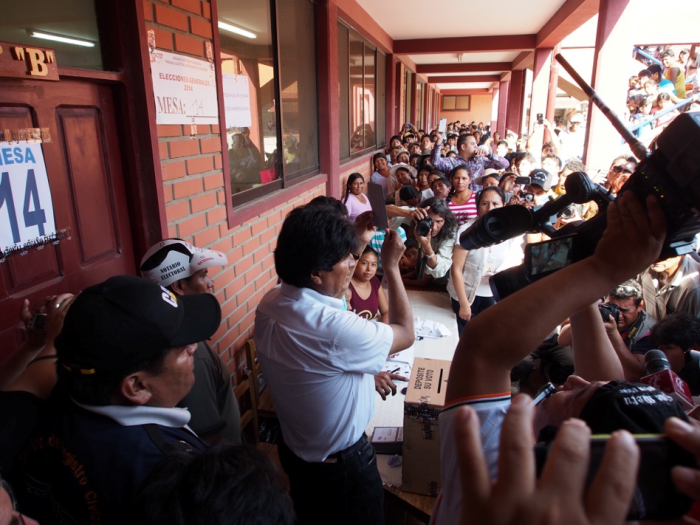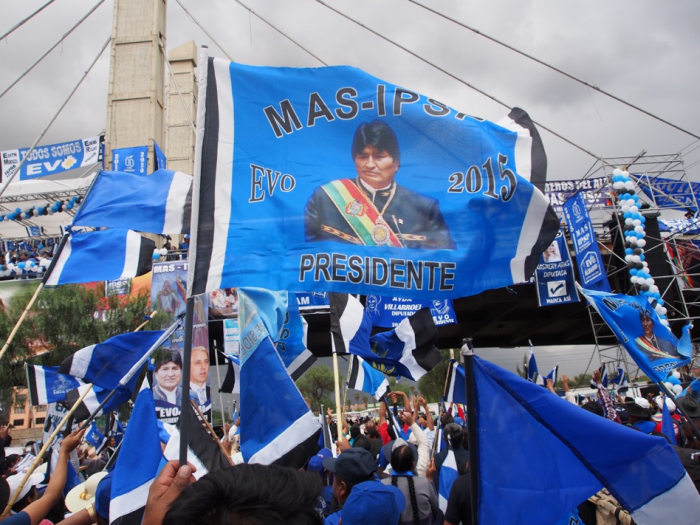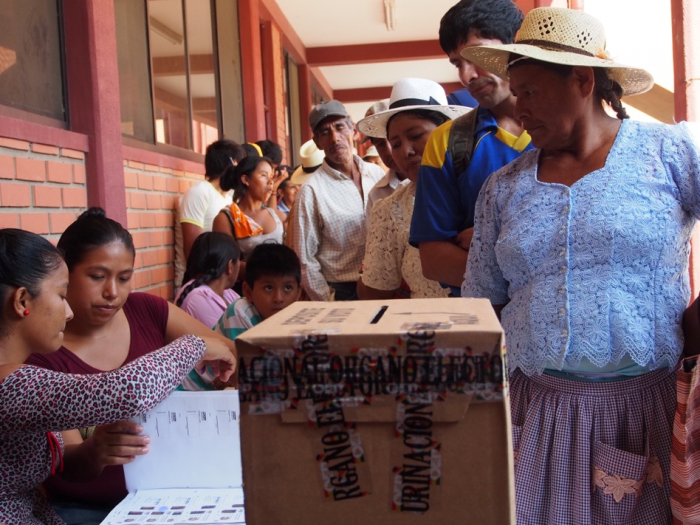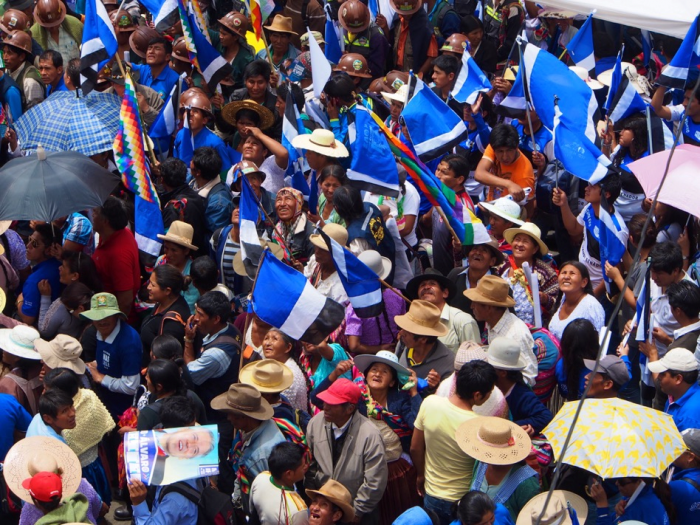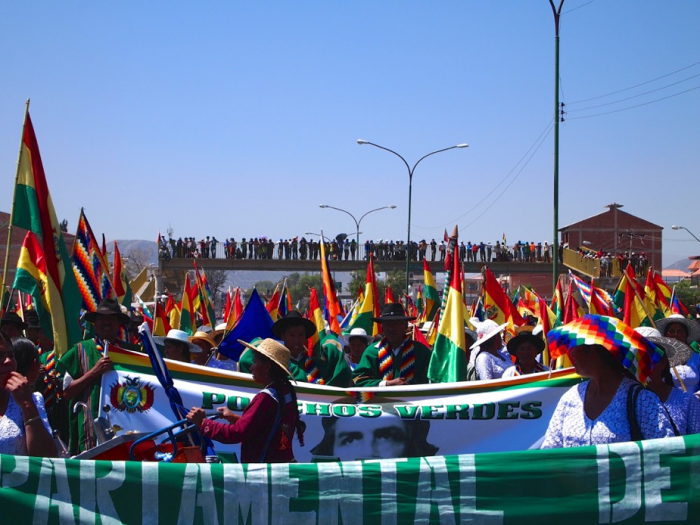This post is part of a series on the Latin American pink tide, moderated and edited by Massimiliano Mollona (Goldsmiths, University of London).
In February 2016 Bolivian President Evo Morales, an indigenous Aymara and former coca grower, lost his bid to amend the Constitution to allow him to stand for a third consecutive term. This was a blow to Morales, who has won re-election twice (in 2009 and 2014), and has triumphed in two previous referendums. Commentators saw the defeat as evidence that the pink tide in Bolivia is receding. But such evaluations are premature; 49 percent of the population still voted in favor of the amendment, and while members of the “no” camp might want to see change at the top, they don’t necessarily want a return to neoliberal orthodoxy. The Morales administration has experienced its fair share of corruption, conflict, division, and poor planning, but on balance most Bolivians have done better under a left-leaning government.
Bolivia, a landlocked country in the very center of South America, is home to around ten million people, the majority of whom consider themselves to be indigenous. Since the Spanish Conquest, Bolivia has suffered from rapacious extraction. During the colonial era, Cerro Rico (literally, “Rich Hill”), a mine in Potosi, produced over half of the world’s gold and silver for more than a hundred years. To this day a popular myth circulates that a bridge made from the valuable metals extracted from Cerro Rico could connect Spain to Latin America. Bolivia has a wealth of other natural resources including tin, rubber, quinine, and gas, but historically these have not been translated into wealth for the population; indeed, the nation remains one of the poorest in the hemisphere.
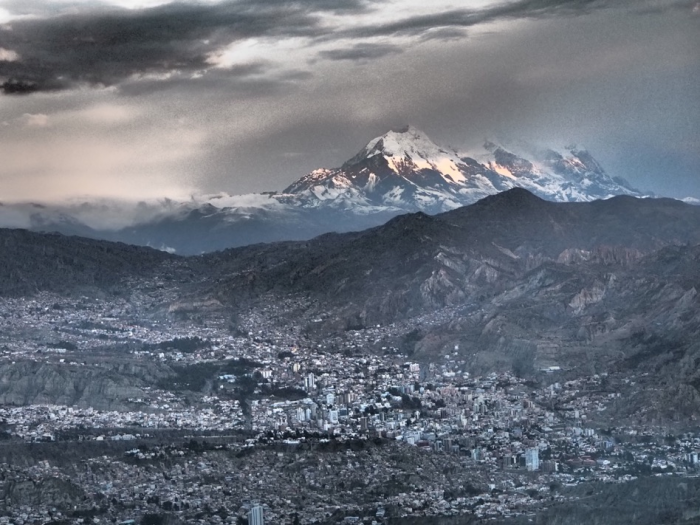
The use and control of Bolivia’s natural resources has long been a focus for social conflict. The most recent and explosive moments were the gas wars of 2003 and 2005, when mass mobilizations sought to block the export of natural gas through Chile and in the process toppled two presidents. The protestors, who represented a broad alliance of social movements mostly concentrated in the city of El Alto, demanded a more socially oriented alternative to the prevailing neoliberal model of economic development and a more participatory democracy. These demands came to be known as the “October Agenda.”
In 2005, against the backdrop of social turmoil and economic crisis, Bolivia elected Evo Morales and his Movement Towards Socialism (MAS by its Spanish acronym) with 54 percent of the vote (the first time any party had secured a majority since the return to democracy in 1982). With a powerful mandate, Morales called for a democratic and cultural revolution. Drawing on the demands specified in the October Agenda he set out to upend the political and social status quo and fashion a new economy geared toward helping people to “live well” (vivir bien) in harmony with nature. During his first year in office, Morales pushed through the part nationalization of the hydrocarbon sector, ended the war on drugs and convened a popularly elected assembly to rewrite the Constitution.
Since 2005 the MAS administration has had many notable triumphs. The middle class has grown to encompass 10 percent of the population, economic growth is greater than it has been in decades, and there have been big advances in terms of civil and social rights. Cash transfers, a new minimum wage, and investment in health, basic infrastructure, and education have improved the lives of the poorest and most vulnerable sectors of society (Farthing and Kohl 2014). The figures speak for themselves; extreme poverty has fallen from 38 percent in 2005 to 17 percent in 2014, and the gap between the richest 10 percent and the poorest 10 percent has fallen from 128 to 39 times (BIF 2016).
One of Morales’s most contentious policies, “coca yes, cocaine no,” has had surprising success. Morales definitively broke with the anti-narcotics model of the United States, replacing the militarized eradication of coca crops with a community-based coca control strategy. The new policy draws on the coca growers’ own distinction between coca leaf, which has been consumed by indigenous Andeans for millennia, and cocaine, the illicit drug. The strategy legalized the cultivation of a small amount of coca leaf in specific zones, encourages agricultural unions to self-police to ensure growers do not exceed this limit, and envisions the industrialization and export of coca-based products such as teas, hand cream, and toothpaste. The program has substantially reduced the coca crop[1] while simultaneously respecting human rights and allowing farmers to diversify their livelihoods. In spite of the program’s benefits, US policymakers have remained steadfastly against this innovative approach (Grisaffi and Ledebur 2016).
With MAS’s success in mind, it is worth noting that reform efforts have been hampered by a range of historical and structural factors. Morales’s ability to redesign the economy along more egalitarian and sustainable lines has been impeded by the nation’s reliance on natural gas revenue and thus foreign capital. As Uruguayan social scientist Eduardo Gudynas (2011) points out, although South America’s progressive governments (specifically Ecuador and Bolivia) are increasing rents[2] from mining, gas, and oil and investing these funds in social programs, there are no substantive changes in the current structure of capital accumulation.[3] This has led some academics to argue that MAS policies represent an important continuity with the neoliberal model (Webber 2010).[4]
Morales promised that he would reconfigure state-society relations by following some of the grassroots tenets of radical democracy. The government convened an assembly to rewrite the Constitution,[5] and Morales consults regularly with social movements through assemblies and congresses. While there have been significant advances in expanding the participation of women and indigenous peoples in government, claims that Bolivia represents a new form of government, run by and for Bolivia’s social movements, are an exaggeration.[6] The MAS’s decision to work within the established political system has impeded the government’s ability to incorporate grassroots decision-making processes, and well-established patterns of corruption, patronage, and authoritarianism soon raised their head (Grisaffi 2013). More worryingly still, Morales has occasionally walked roughshod over the grassroots movements that put him in power, including miners and some indigenous groups (Fabricant and Postero 2014; Perreault 2015).
The farming oligarchs in Bolivia’s eastern lowlands have posed the most serious threat to the Morales administration. These land-owning elites have mounted obstacles to even the most modest social and economic reforms proposed by the government and have on occasion declared de facto regional autonomy. The right-wing movements have advanced their “autonomous” agenda through their control over the mass media (including newspapers and TV channels), staging mass rallies, and they have employed extra-legal violence. The Cruceño Youth Union (UJC by its Spanish acronym) is infamous for its violent assaults on indigenous peasants and the urban poor. Because of the threat posed by the right, Morales has had to make significant concessions, including diluting land reform proposals.
Overall the picture that emerges of the MAS is one of enormous challenges and considerable shortcomings (Farthing and Kohl 2014). Given the unrealistically high expectations that accompanied the MAS’s accession to power, it is unsurprising that some grassroots activists feel disillusioned.[7] Even so, the urban and rural poor, who constitute the majority of the population, do not want to see th18e gains made over the past ten years wiped out by an incoming authoritarian neoliberal government. Thus, there is still commitment from popular social movements to support the “process of change.” Morales’s failure to secure a third term in office therefore should not be taken to imply that the (pink) tide is out in Bolivia.
Thomas Grisaffi is a postdoctoral Research Fellow at University College London (UCL). He holds a PhD in Social Anthropology from the University of Manchester. His research focuses on trade unions, coca, and democracy in Bolivia.
Notes
[1] Coca cultivation in Bolivia now stands at around 20,000 hectares, less than half the amount found in Peru, where forced eradication continues apace.
[2] International reserves have grown to over $13 billion, and state investment over the past ten years has totaled $30 billion (BIF 2016).
[3] The social and environmental impacts of the extractive industries remain the same, and some instances have even become worse. For more on this see Bebbington and Bury (2013).
[4] It is telling that the World Bank and the International Monetary Fund have commended Morales’s management of the economy (Neuman 2014).
[5] As a result of pressure from a resurgent right, the Constituent Assembly that was introduced by the Morales government precluded many of the social movement’s more revolutionary and participatory demands.
[6] Vice President Álvaro García Linera has declared, “Evo-ism as a political and ideological current, is a form of political self-representation that allows social movements access to decision-making levels of the state” ( Mayorga 2009, my translation).
[7] Over recent years, there has been a proliferation of local level road blockades and protests.
References
Bebbington, Anthony, and Jeffrey Bury, eds. 2013. Subterranean struggles: New dynamics of mining, oil, and gas in Latin America. University of Texas Press: Austin.
Fabricant, Nicole, and Nancy Postero. 2014. Performing the “wounded Indian”: A new platform of democracy and human rights in Bolivia’s autonomy movement. Identities 21 (4): 395–411.
Farthing, Linda, and Benjamin Kohl. 2014. Evo’s Bolivia: Continuity and change. Austin: University of Texas Press.
Grisaffi, Thomas. 2013. All of us are presidents: Radical democracy and citizenship in the Chapare Province, Bolivia. Critique of Anthropology 33(1): 47–65. doi: 10.1177/0308275X12466681.
Grisaffi, Thomas, and Kathryn Ledebur. 2016. Citizenship or repression? Coca, eradication and development in the Andes. Stability: International Journal of Security and Development 5(1). doi: http://doi.org/10.5334/sta.440.
Gudynas, Eduardo. 2011. El nuevo Extractivismo progresista en America del Sur: Tesis sobre un viejo problema bajo nuevas expresiones. In Alberto Acosta, Eduardo Gudynas, François Houtart, Luis Macas, J Martinez Alier, Henry Ramirez Soler, and Emma Siliprandi, eds., Colonialismos del Siglo XXI: Negocios extractivos y defensa del territorio en América Latina, pp. 75–92. Barcelona: Icaria Editorial.
Mayorga, Rene. 2009. Bolivia Sociedad civil y Estado bajo un popul18ismo plebiscitario y autoritario. In Cynthia Arnson, Ariel Armony, Catalina Smulovitz, Gastón Chillier, Enrique Peruzzotti and Giselle Cohen, eds., La “Nueva Izquierda” en America Latina: Derechos humanos, participacion politica, y sociedad civil, pp. 106–114. Washington, DC: Woodrow Wilson Center.
Neuman, William. 2014. “Turnabout in Bolivia as economy rises from instability.” The New York Times, 16 February.
Perreault, Tom. 2015. Performing participation: Mining, power, and the limits of public consultation in Bolivia. Journal of Latin American and Caribbean Anthropology 20(3): 433–451.
Webber, Jeffery. 2010. From rebellion to reform in Bolivia: Class struggle, indigenous liberation, and the politics of Evo Morales. Chicago: Haymarket Books.
Cite as: Grisaffi, Thomas. 2016. “After the Referendum: Evo Morales and the Movement Towards Socialism.” FocaalBlog, 18 April. www.focaalblog.com/2016/04/18/thomas-grisaffi-after-the-referendum-evo-morales-and-the-movement-towards-socialism.
